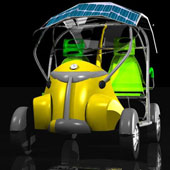The project 'Solar Powered Rickshaw' deals with designing of a light weight solar powered slow moving public/ semipublic vehicle (car/ buggy/ cart) for Indian use.
The Solar logic:
The greatest problem that the world faces today is of Global warming. It is more apparent here in India than anywhere else. Especially in Rajasthan – Where the temperatures over the last few years have risen from 32deg C to36deg C to last summer of 42deg C to 46 deg C.
The technology developed by Maharana of Mewar Trust resulted into the development of a vehicle which runs on solar energy.
According to the narrator the need for intervention of an industrial designer in the project was seen at various levels. Like -
• Making the product more ergonomically correct than seeing it as only scope for providing some aesthetic character.
• Also, to enhance and develop the overall structure and materials based on the specific application areas.

Aim:
The aim of the project was not to develop a vehicle which competes with other vehicles in the automobile sector but was to identify its specific niche and generate an alternative suitable option for the more ecologically conscious generation.
'Inside out - to Outside in' approach was taken which form well integrated with material and structure and complimentary to the overall functional requirements, interior elements with certain level of flexibility, innovation and convenience.
The current market is flooded with newer faster cars which are designed and fabricated with a western context in mind. Here, the narrator had made an attempt to look at the meaning of the expression 'Indian vehicle' and the different levels it corresponds to.
The vehicle not only seeks 'Indian-ess' through its visual identity but when it incorporates issues of Indian climate, technology and behavior of the people in its conception. It is time we start catering to the need for a tropical vehicle. It is a search for the vernacular in the automobile.
Case Study Downloads:
• Solar Powered Rickshaw - Design of a Solar Powered Vehicle - pdf


